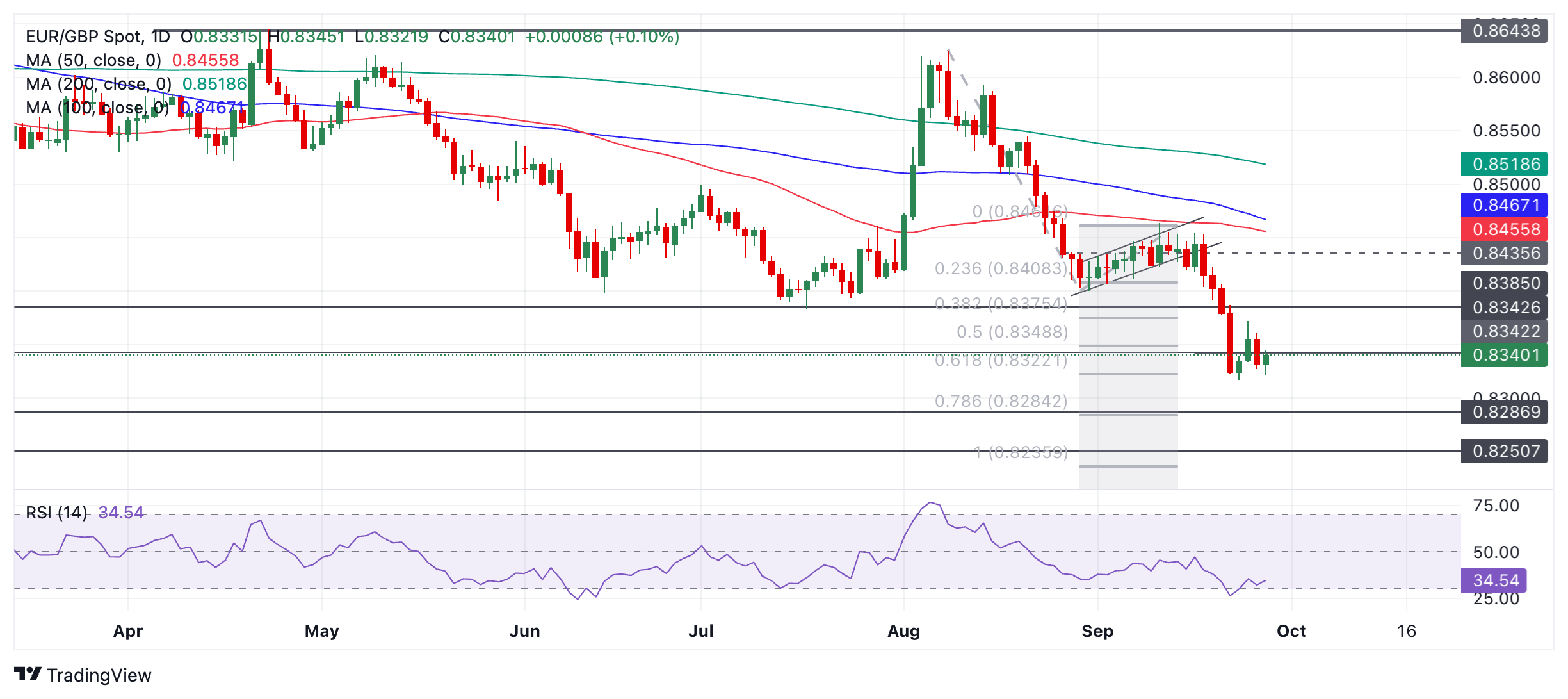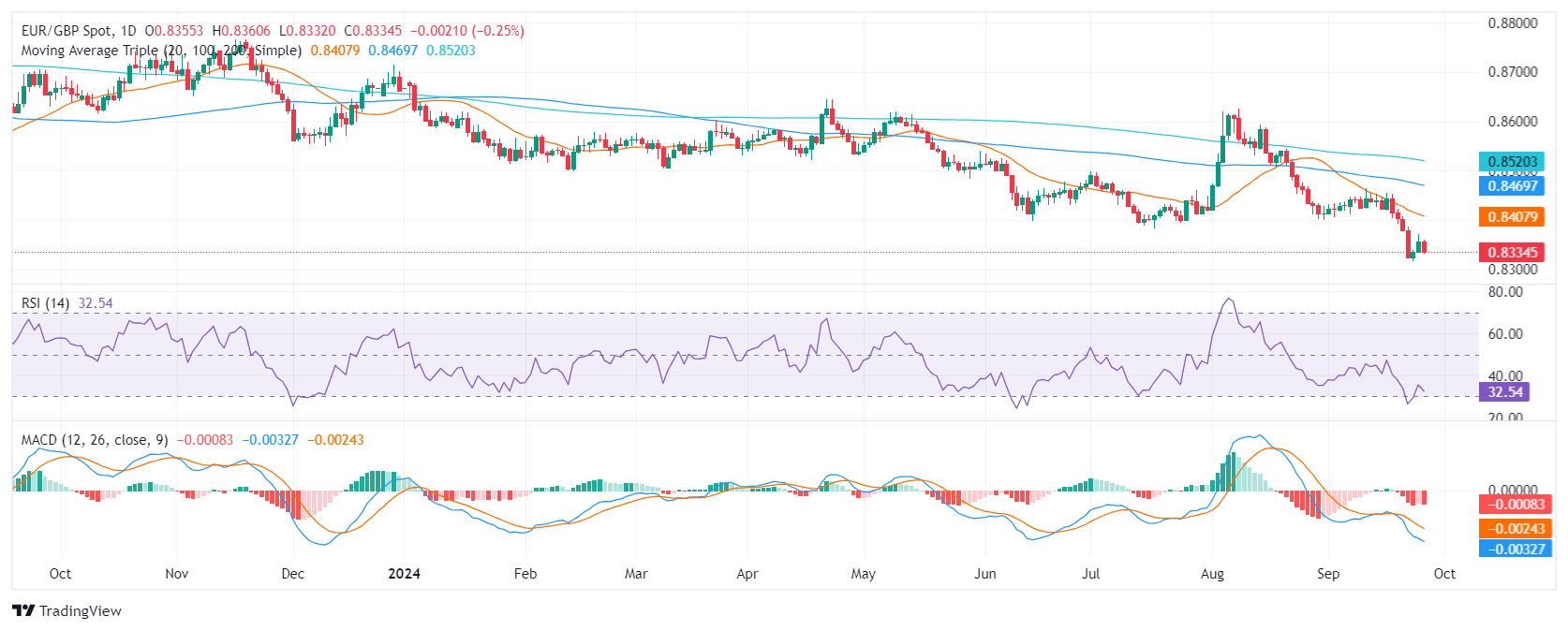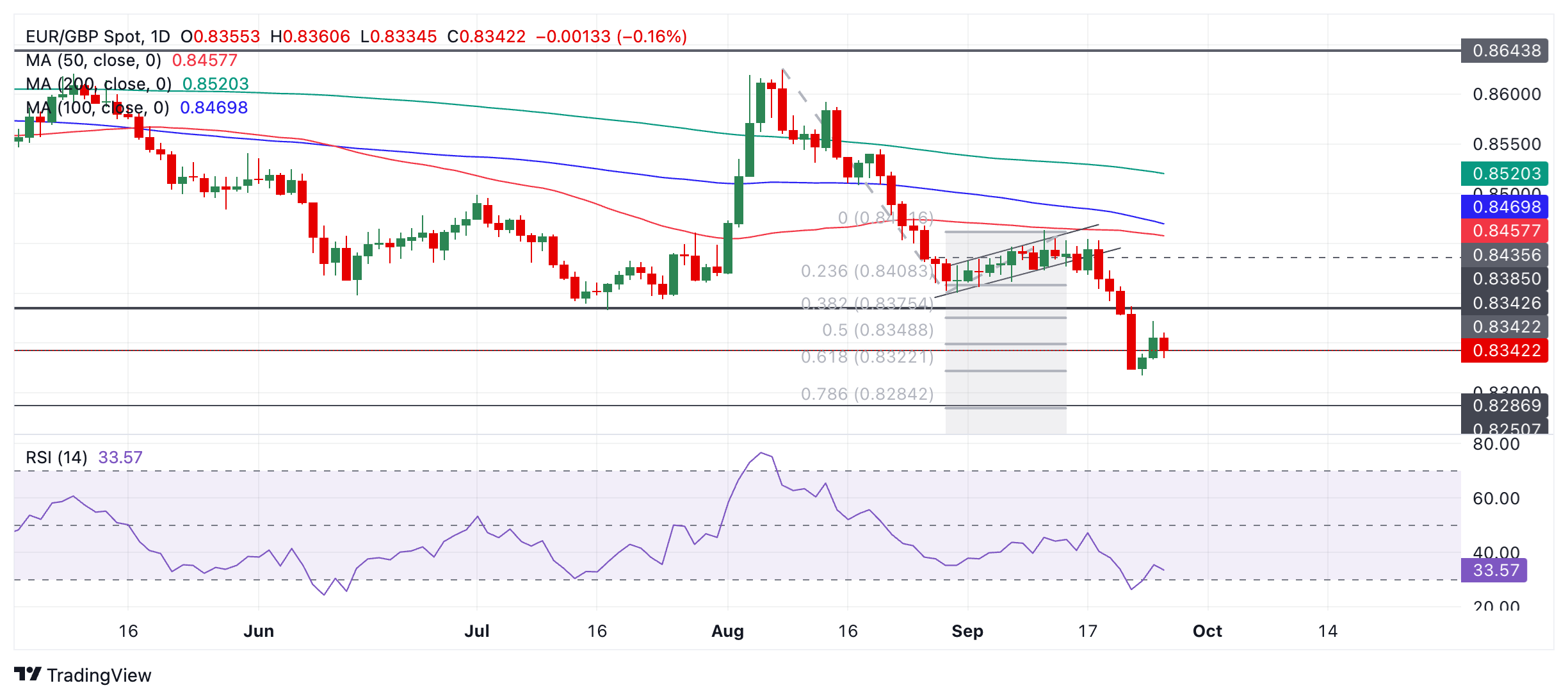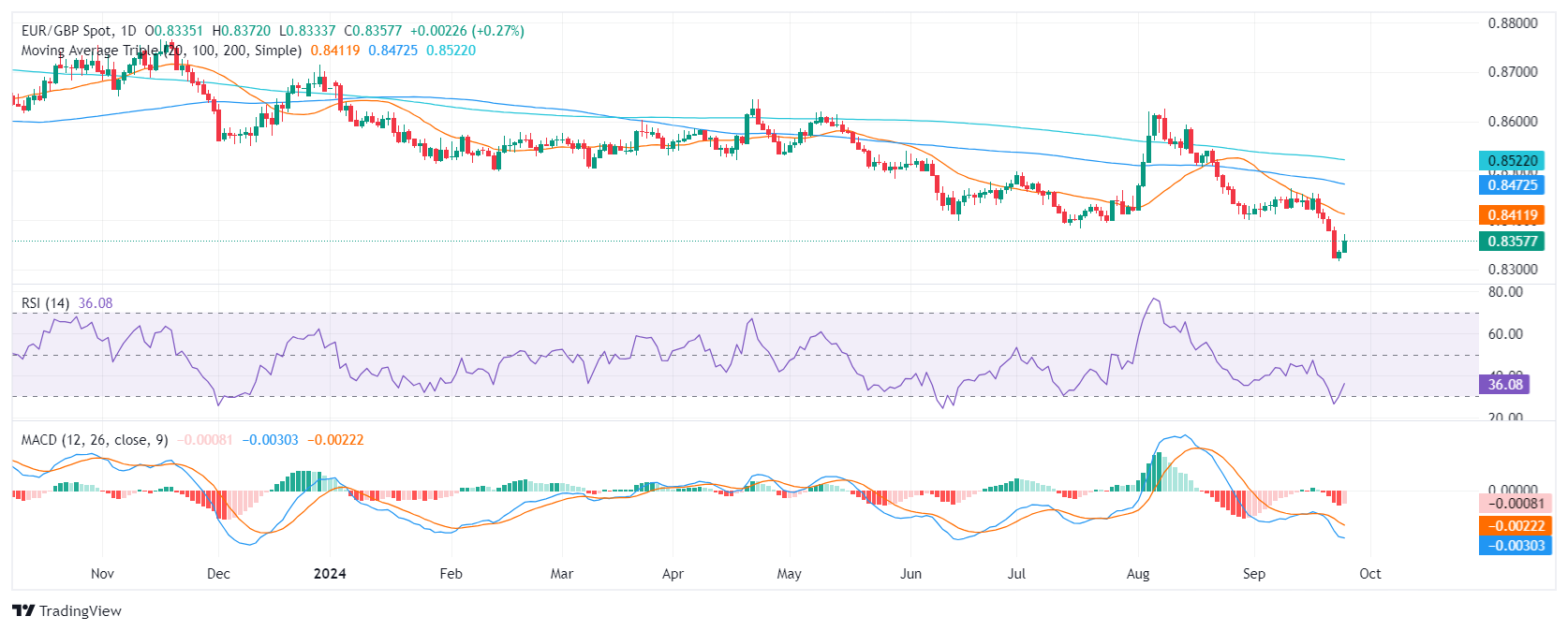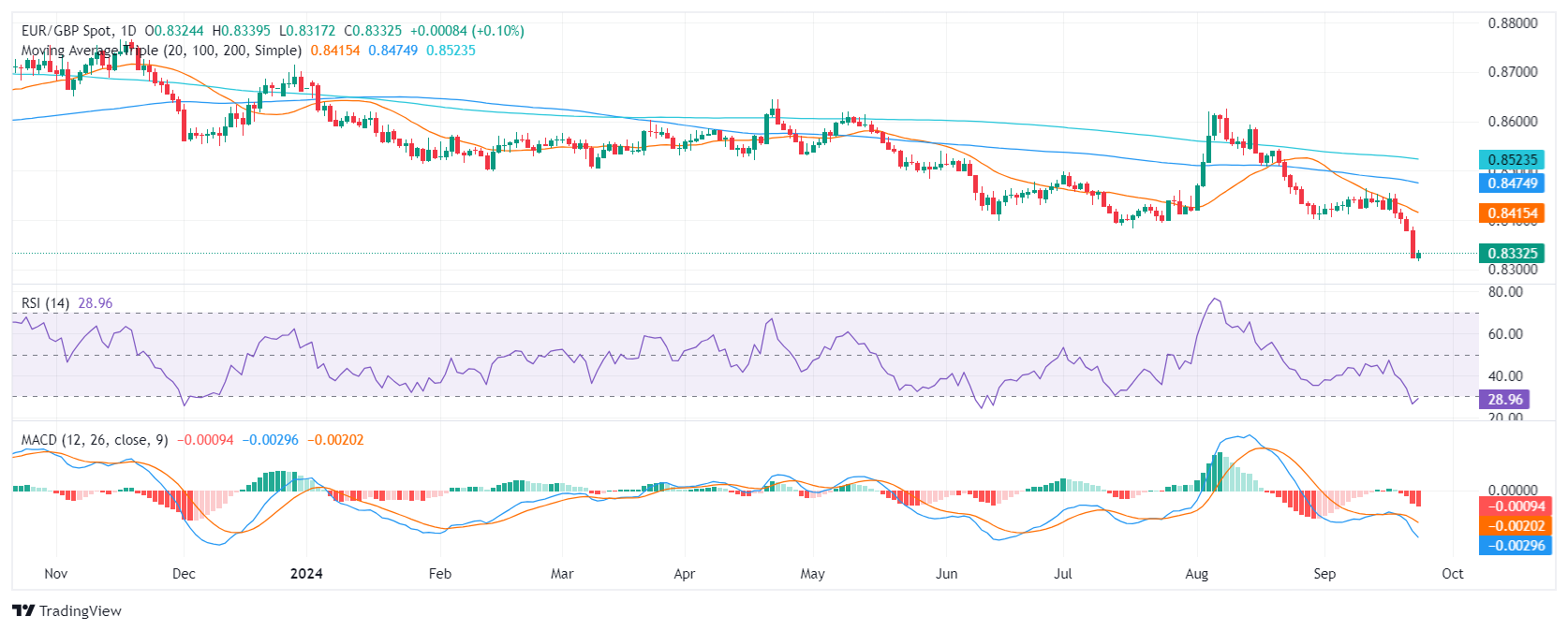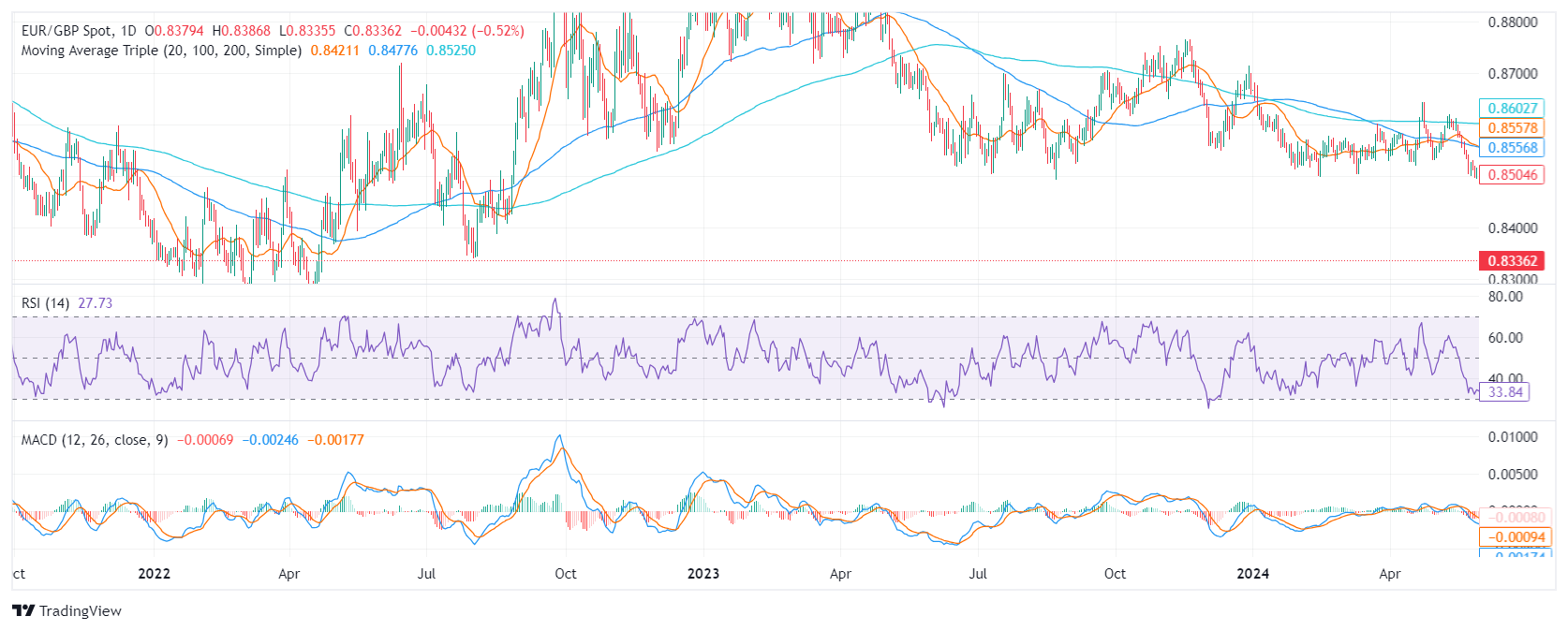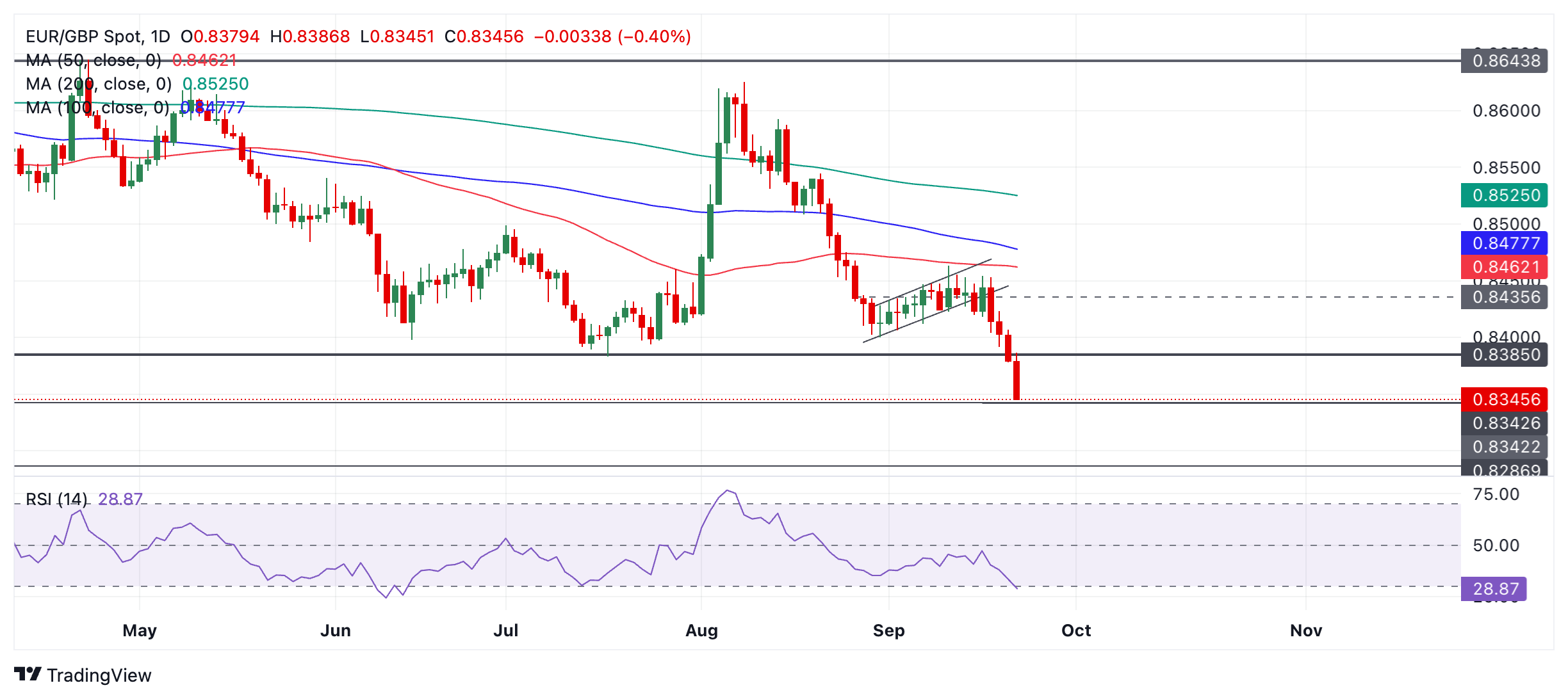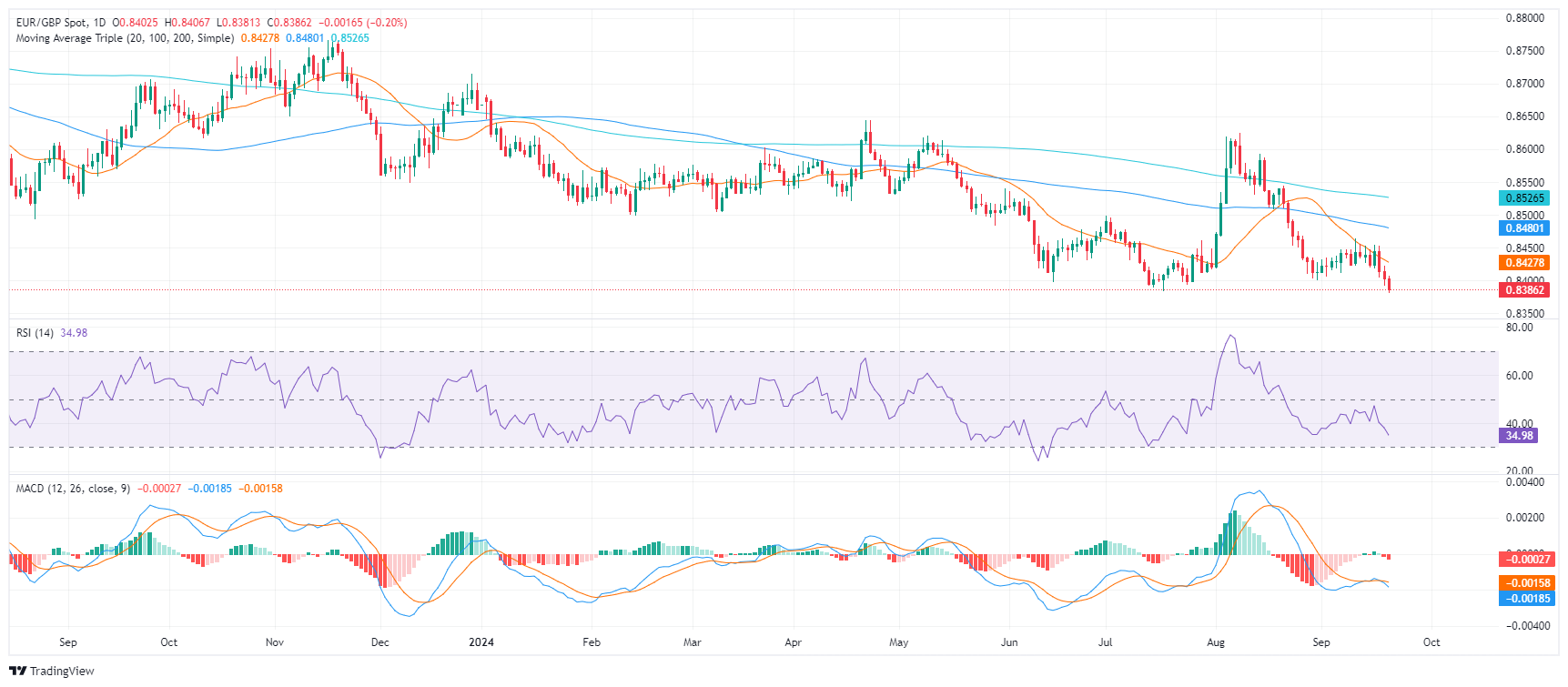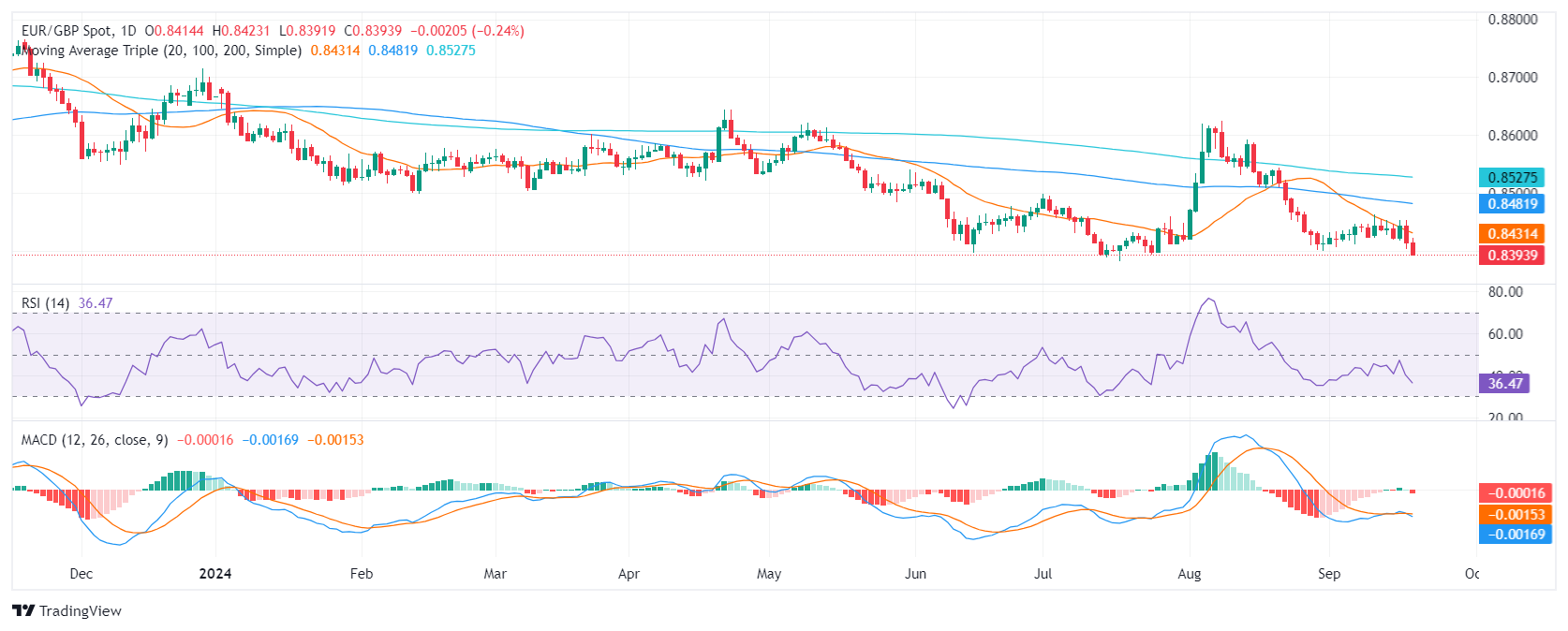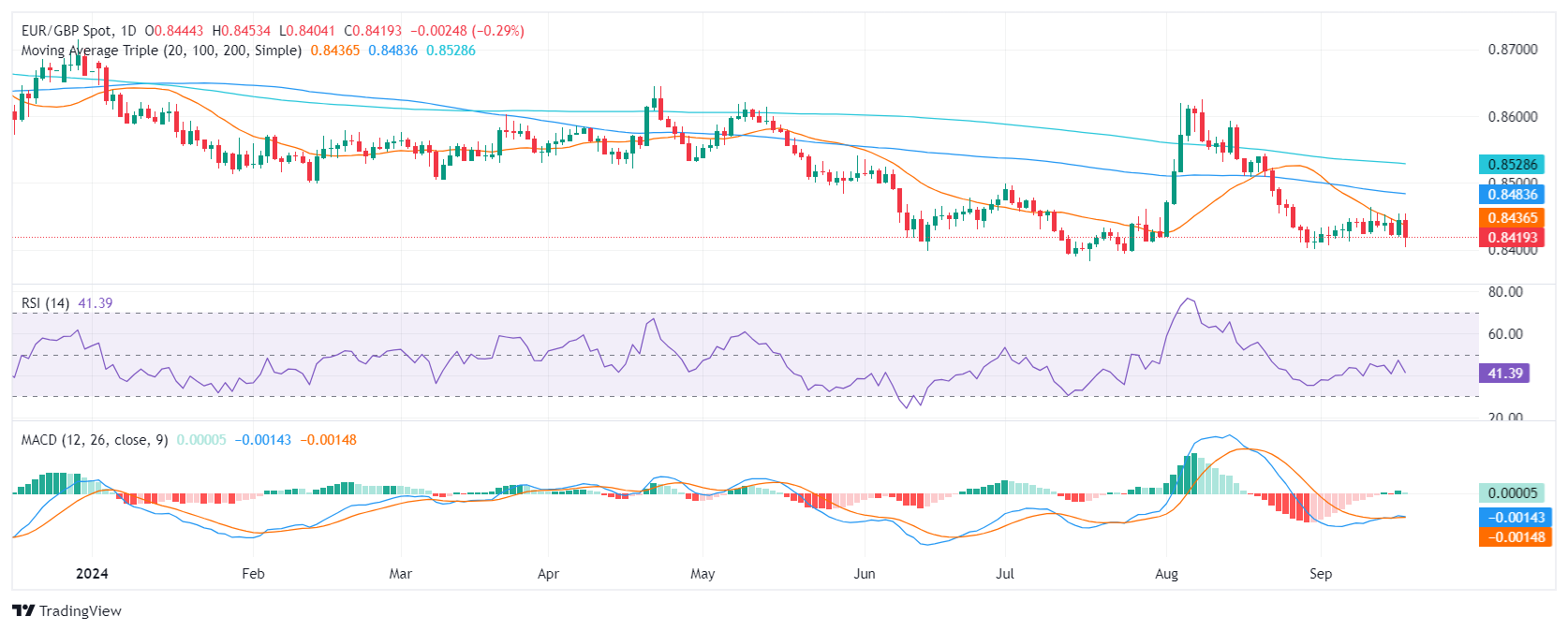- Analytics
- News and Tools
- Quotes
- Chart and quotes for EURGBP
CFD Trading Rate Euro vs Great Britain Pound (EURGBP)
| Date | Rate | Change |
|---|
Related news
-
27.09.2024 13:29EUR/GBP Price Forecast: Resumes downside bias
- EUR/GBP appears to have stalled after pulling back higher from the September 24 lows.
- The pair may be resuming its downtrend and could break lower.
EUR/GBP stalls in its pull back from the September 24 lows and resumes its downside bias.
The pair is in a short and medium-term downtrend which given the technical analysis theory that “the trend is your friend” is more likely than not to continue.
EUR/GBP Daily Chart
That said, EUR/GBP has now reached the first downside target for the bear move that began at the August 5 high and this could indicate the end of its decline. The target is the 61.8% extrapolation of the initial move down during August before the channel that formed in early September.
A break below the 0.8317 September 24 low would reconfirm a continuation of the downtrend towards the next target at 0.8287, the August 2022 low.
The Relative Strength Index (RSI) exited oversold after the bounce on September 24 and this could indicate the risk that a stronger correction may still unfold higher.
-
27.09.2024 06:18EUR/GBP appreciates to near 0.8350, eyes on ECB officials
- EUR/GBP gains ground ahead of the speeches from ECB’s Philip Lane and Piero Cipollone on Friday.
- The Euro may face challenges as the ECB is widely expected to deliver another rate cut in October.
- The Pound Sterling receives support as the BoE is expected to reduce rates more gradually compared to other central banks.
EUR/GBP retraces its recent losses from the previous session, trading around 0.8340 during Friday’s Asian hours. However, further gains may be limited, as the Euro’s performance against major currencies remains weak amid increasing speculation that the European Central Bank (ECB) could lower the Deposit Facility Rate for the second consecutive time next month. This would mark the ECB's third dovish move this year.
ECB Chief Economist Philip Lane will likely deliver the opening remarks at a conference focused on Fiscal Policy, Financial Sector Policy, and Economic Growth in Dublin, Ireland. Meanwhile, ECB board member Piero Cipollone will give a keynote speech at the "Economics of Payments XIII" conference, organized by the Austrian Central Bank.
According to a Reuters report, economists at HSBC anticipate that the ECB will reduce interest rates by 25 basis points at each meeting from October through next April. Meanwhile, Societe Generale economist Anatoli Annenkov suggested there is a case for front-loading the rate cuts, indicating a preference for more aggressive action earlier in the easing cycle.
On the GBP side, expectations that the Bank of England's (BoE) rate-cutting cycle will likely proceed more slowly than the ECB’s should continue to support the British Pound (GBP) and exert downward pressure on the EUR/GBP cross.
The BoE allotted 37.059 billion pounds ($49.52 billion) in seven-day funds during its weekly short-term repo on Thursday, down from last week’s record of 44.523 billion pounds. Repos, or repurchase agreements, allow banks to temporarily exchange government bonds for central bank cash, helping to maintain market interest rates in line with the BoE’s policy rate, according to Reuters.
Interest rates FAQs
Interest rates are charged by financial institutions on loans to borrowers and are paid as interest to savers and depositors. They are influenced by base lending rates, which are set by central banks in response to changes in the economy. Central banks normally have a mandate to ensure price stability, which in most cases means targeting a core inflation rate of around 2%. If inflation falls below target the central bank may cut base lending rates, with a view to stimulating lending and boosting the economy. If inflation rises substantially above 2% it normally results in the central bank raising base lending rates in an attempt to lower inflation.
Higher interest rates generally help strengthen a country’s currency as they make it a more attractive place for global investors to park their money.
Higher interest rates overall weigh on the price of Gold because they increase the opportunity cost of holding Gold instead of investing in an interest-bearing asset or placing cash in the bank. If interest rates are high that usually pushes up the price of the US Dollar (USD), and since Gold is priced in Dollars, this has the effect of lowering the price of Gold.
The Fed funds rate is the overnight rate at which US banks lend to each other. It is the oft-quoted headline rate set by the Federal Reserve at its FOMC meetings. It is set as a range, for example 4.75%-5.00%, though the upper limit (in that case 5.00%) is the quoted figure. Market expectations for future Fed funds rate are tracked by the CME FedWatch tool, which shapes how many financial markets behave in anticipation of future Federal Reserve monetary policy decisions.
-
26.09.2024 16:08EUR/GBP Price Analysis: Pair hovers around 0.8330, bearish outlook intact
- The EUR/GBP has steadily declined over the past trading days.
- The RSI and MACD are both suggesting that selling pressure is rising.
- Oversold conditions might prompt an upward correction.
The EUR/GBP pair has been in a steady decline over the past trading days and fell to 0.8330 on Thursday with 0.30% losses.The Relative Strength Index (RSI) is suggesting that selling pressure is rising, with the RSI value at 33, in the near oversold area, and a declining slope. The Moving Average Convergence Divergence (MACD) also suggests that selling pressure is rising, with the MACD histogram red and rising.
EUR/GBP Daily Chart
Based on the current technical picture, the EUR/GBP pair is likely to remain under pressure in the near term. The bears seem to be in control, and the bulls need to break above the 0.8400 resistance level to regain control. If the bears manage to break below the 0.8300 support level, the pair could fall further. However, with indicators flashing oversold signals, traders shouldn't take off the table an upward correction.
-
26.09.2024 12:22EUR/GBP Price Forecast: Pulling back within downtrend
- EUR/GBP is correcting back after an extended down move which took the pair to a key target level.
- The RSI momentum indicator has exited oversold and given a buy signal.
EUR/GBP has pulled back after trending lower. It remains in a short and medium-term downtrend, however, suggesting the decline could resume. It is a principle of technical analysis that “the trend is your friend” which means that the odds favor a continuation of the bear trend for EUR/GBP.
EUR/GBP Daily Chart
That said, EUR/GBP has reached a potential downside target for the bear move that began at the August 5 high when it reached the top of its range. As such it may have completed its bearish decline. The target is the 61.8% extrapolation of the initial move down during August before the channel that formed in early September and pulled back higher for two weeks.
A break below the 0.8317 September 24 low would reconfirm a continuation of the downtrend towards the next target at 0.8287, the August 2022 low.
The Relative Strength Index (RSI) has exited oversold, suggesting the risk of an extended correction unfolding to the upside.
-
26.09.2024 07:04EUR/GBP consolidates above 0.8350 ahead of ECB’s Lagarde speech
- EUR/GBP remains flat near 0.8355 in Thursday’s early European session.
- The BoE policymaker confirmed it’s appropriate to only cut rates at a gradual pace.
- The ECB is expected to cut deeper interest rates until April next year, noted HSBC analysts.
The EUR/GBP cross flat lines around 0.8355 during the early European session on Thursday. However, a less dovish stance from the Bank of England (BoE) might provide some support to the Pound Sterling (GBP). Traders will take more cues from the European Central Bank's (ECB) policymakers' speeches later in the day, including ECB President Christien Lagarde, Frank Elderson and Luis de Guindos.
The cautious stance of the Bank of England (BoE) could underpin the GBP against the Euro (EUR). BoE policymaker Megan Greene said on Wednesday “I believe the risks to activity are to the upside, which could suggest that the long-run neutral rate is higher and - all else equal - our stance of policy isn’t as restrictive as we had thought. Given this risk, I believe it is appropriate to take a gradual approach to removing restrictiveness.”
On the other hand, the downbeat Germany’s IFO reports earlier this week added to German recession fears, prompting the expectation of additional rate cuts and might cap the upside for the Euro (EUR) in the near term. The ECB is likely to cut deeper interest rates than previously expected, by lowering its key deposit rate by 25 basis points (bps) at each of its upcoming meetings from now until April next year, noted HSBC analysts. The Eurozone Consumer Confidence and Industrial Confidence for September will be published on Friday. Any signs of improvement in the Eurozone economy could help limit the shared currency’s losses in the near term.ECB FAQs
The European Central Bank (ECB) in Frankfurt, Germany, is the reserve bank for the Eurozone. The ECB sets interest rates and manages monetary policy for the region. The ECB primary mandate is to maintain price stability, which means keeping inflation at around 2%. Its primary tool for achieving this is by raising or lowering interest rates. Relatively high interest rates will usually result in a stronger Euro and vice versa. The ECB Governing Council makes monetary policy decisions at meetings held eight times a year. Decisions are made by heads of the Eurozone national banks and six permanent members, including the President of the ECB, Christine Lagarde.
In extreme situations, the European Central Bank can enact a policy tool called Quantitative Easing. QE is the process by which the ECB prints Euros and uses them to buy assets – usually government or corporate bonds – from banks and other financial institutions. QE usually results in a weaker Euro. QE is a last resort when simply lowering interest rates is unlikely to achieve the objective of price stability. The ECB used it during the Great Financial Crisis in 2009-11, in 2015 when inflation remained stubbornly low, as well as during the covid pandemic.
Quantitative tightening (QT) is the reverse of QE. It is undertaken after QE when an economic recovery is underway and inflation starts rising. Whilst in QE the European Central Bank (ECB) purchases government and corporate bonds from financial institutions to provide them with liquidity, in QT the ECB stops buying more bonds, and stops reinvesting the principal maturing on the bonds it already holds. It is usually positive (or bullish) for the Euro.
-
25.09.2024 16:04EUR/GBP Price Analysis: Pair finds stabilizes at 0.8350, technical outlook remains bearish
- EUR/GBP retraced Monday’s sharp downward movements.
- The daily RSI and MACD signals a stabilizing selling pressure.
- The pair might extend its current sideways trend in the next sessions.
EUR/GBP rose to 0.8370 on Wednesday, displaying some volatility during the European trading session. Nevertheless, the pair failed to hold on to gains, and it currently trades at 0.8350. The cross seems to be consolidating the start of the week’s sharp downward movements with sellers taking a breather.
The Relative Strength Index (RSI) on the daily chart stands at 37, suggesting that buyers are starting to take control after Monday’s selloff, and the RSI is gradually increasing. However, the RSI is still below the midline, indicating that the market is in a negative trend. The Moving Average Convergence Divergence (MACD) is flat, with the signal line above the MACD line, suggesting that selling is losing steam.
EUR/GBP daily chart
Based on the current technical picture, the EUR/GBP pair is likely to remain in a consolidation phase in the near term. With the pair in lows since 2022, the bears seem to have already done their part and they might step away to consolidate their movements. In the meantime, the bullish traction gained on Wednesday continues to be weak so the current bearish scenario isn’t threatened.
Support levels: 0.8315, 0.8330, 0.8340
Resistance levels :0.8400, 0.8430, 0.8440 -
25.09.2024 12:53EUR/GBP continues recovery sparked by Governor Bailey’s dovishness
- EUR/GBP is rising for the second day in a row after comments from BoE’s Bailey
- The BoE Governor’s comments suggested interest rates would continue falling gradually as inflation eased.
- The Euro remains under pressure by weak data and rising bets of the ECB cutting rates in October.
EUR/GBP continues its recovery, trading up 0.40% in the 0.8360s on Wednesday. The Pound started losing ground against the single currency after commentary from Bank of England (BoE) governor Andrew Bailey, in which he said that he saw interest rates continuing to fall gradually. This, in turn, put pressure on Sterling since lower interest rates attract less capital inflows.
“I'm very encouraged that the path of inflation is downwards therefore I do think the path for interest rates will be downwards, gradually, to the ´neutral’ rate,” Bailey said on Tuesday. The neutral rate of interest is the long run equilibrium level, or “ideal” level for interest rates in the economy.
His remarks come after a close call five-to-four vote at the BoE’s August meeting backed up a quarter point cut from the bank, pushing borrowing costs down to 5.00%. Financial markets, meanwhile, are pricing in a drop to 4.5% by the end of 2024, and lower to 3.5% by the end of 2025.
BoE policymaker Megan Greene was more hawkish than Bailey on Wednesday when she said that a “cautious, steady-as-she-goes approach to monetary policy easing is appropriate.”
Greene added “I believe the risks to activity are to the upside, which could suggest that the long-run neutral rate is higher and - all else equal - our stance of policy isn’t as restrictive as we had thought.” Greene was one of four on the MPC who voted to hold rates in August.
EUR/GBP rebounds despite increasing odds of an ECB Autumn cut
The Euro rallies against the Pound despite increasing odds the European Central Bank (ECB) will announce a 0.25% cut to its main refinancing operations rate in October, bringing it down to 3.40% from 3.65%, and thereby increasing the differential with the BoE.
“Despite the Fed’s 50 bps cut, the ECB is widely expected to wait until December to deliver its next rate cut, though yesterday’s weak PMI readings as well as today’s Ifo have pushed market pricing closer to a 50/50 for a rate cut already at the next meeting in October," said Anders Svendsen, Chief Analyst at Nordea Bank.
The Euro solf-off heavily on Monday after the release of HCOB Purchasing Manager Index (PMI) data showed a stark decline in activity in the Eurozone economy, with the Composite PMI falling from growth territory (above 50) to contraction (below 50).
There then followed a below-expectations IFO German business sentiment index score in September – the IFO is a survey of 7,000 enterprises regarding the state of the economy and the outlook.
Both the IFO Business Climate and Current Assessment indexes fell below both previous readings for August and economists’ forecasts. The IFO Expectations index, meanwhile, matched forecasts but was still lower than the previous month’s reading. The data reinforces the view that the German economy is at risk of falling into a recession.
Stronger GBP unlikely to feedback into lower inflation - Commerzbank
Speculation that the strengthening Pound – the major that has risen the most against the US Dollar (GBP) since the beginning of 2024 – would lead to lower imported inflation and thereby bring down UK inflation as a whole, were dismissed by Commerzbank’s FX Analyst Michael Pfister, on Wednesday.
“In the UK, almost all inflationary pressure now comes from services. The role of goods is less important. In fact, in recent months we have even seen outright goods deflation in some areas, which has helped to push down the core rate. The slight turnaround that has since taken place confirms our view,” said Pfister in a note.
If a stronger Pound were to bring inflation down it would encourage the BoE to cut interest rates more aggressively, eventually weakening Sterling and counterbalancing the strength that had led to the lower inflation in the first place.
However, Pfister sees little chance of this unless GBP can rise substantially higher in order for deflationary goods inflation to completely smother services inflation.
“Since the beginning of the year, the GBP has gained almost 5% against the USD. That makes it by far the best performing G10 currency, but it probably won't be enough. GBP would probably need to appreciate much more for the persistently high services inflation to narrow the gap between the core rate and the target,” said the analyst.
-
25.09.2024 05:30EUR/GBP gains traction to near 0.8350 ahead of BoE’s Greene speech
- EUR/GBP drifts higher to 0.8345 in Wednesday’s early European session.
- The BoE’s dovish stance continues to weigh on the Pound Sterling.
- The downbeat German IFO reports have added to German recession fears, which might cap the cross’s upside.
The EUR/GBP pair rebounds near 0.8345 during the early European session on Wednesday. The dovish remarks from Bank of England (BoE) Governor Andrew Bailey weigh on the Pound Sterling (GBP). Investors will take more cues from the BoE’s Megan Greene later in the day.
The BoE Governor Andrew Bailey said he was “very encouraged” by the downward path of inflation, and he expected the path for interest rates will be downwards gradually. However, Bailey warned consumers not to expect a return to near-zero levels. Bailey’s comments suggested that the UK central bank would continue its easing policy over a long period, which exerts some selling pressure on the GBP. The financial markets anticipate the interest rates could drop to 4.5% by the end of 2024, and lower to 3.5% by the end of 2025.
On the Euro front, Germany’s IFO Index dropped for the fifth consecutive month, indicating the economy remains stuck in stagnation. The German IFO Business Climate Index declined to 85.4 in September from 86.6 in August, below the consensus of 86.0. The Current Economic Assessment Index dropped to 84.4 versus 86.4 prior (revised from 86.5). Finally, the IFO Expectations Index declined to 86.3 in September from 86.8 in August, matching the expectations.
The fall in Germany’s IFO reports has added to German recession fears, which might cap the upside for the cross in the near term. On Tuesday, the ECB governing council member Klaas Knot stated that the central bank would continue to reduce the interest rates at least through the first half of 2025 to a level between 2% and 3%, per Reuters.BoE FAQs
The Bank of England (BoE) decides monetary policy for the United Kingdom. Its primary goal is to achieve ‘price stability’, or a steady inflation rate of 2%. Its tool for achieving this is via the adjustment of base lending rates. The BoE sets the rate at which it lends to commercial banks and banks lend to each other, determining the level of interest rates in the economy overall. This also impacts the value of the Pound Sterling (GBP).
When inflation is above the Bank of England’s target it responds by raising interest rates, making it more expensive for people and businesses to access credit. This is positive for the Pound Sterling because higher interest rates make the UK a more attractive place for global investors to park their money. When inflation falls below target, it is a sign economic growth is slowing, and the BoE will consider lowering interest rates to cheapen credit in the hope businesses will borrow to invest in growth-generating projects – a negative for the Pound Sterling.
In extreme situations, the Bank of England can enact a policy called Quantitative Easing (QE). QE is the process by which the BoE substantially increases the flow of credit in a stuck financial system. QE is a last resort policy when lowering interest rates will not achieve the necessary result. The process of QE involves the BoE printing money to buy assets – usually government or AAA-rated corporate bonds – from banks and other financial institutions. QE usually results in a weaker Pound Sterling.
Quantitative tightening (QT) is the reverse of QE, enacted when the economy is strengthening and inflation starts rising. Whilst in QE the Bank of England (BoE) purchases government and corporate bonds from financial institutions to encourage them to lend; in QT, the BoE stops buying more bonds, and stops reinvesting the principal maturing on the bonds it already holds. It is usually positive for the Pound Sterling.
-
24.09.2024 16:12EUR/GBP Price Analysis: Bulls regain some ground as the pair consolidates
- EUR/GBP consolidates Monday’s sharp downward movements.
- The RSI suggests oversold conditions but the MACD signals a stabilizing selling pressure.
- The pair might side-ways trade in the next sessions as bears might take a breather.
EUR/GBP recovered some lost ground on Tuesday, rising mildly to 0.8330, but the overall technical outlook remains bearish as the pair stands at multi-year lows.A mild oversold condition is currently seen in the pair according to a reading of 27 for the Relative Strength Index (RSI), suggesting that buyers are starting to take control after Monday’s selloff, and the RSI is gradually increasing. The Moving Average Convergence Divergence (MACD) is flat, suggesting that selling is losing steam.
EUR/GBP daily chart
Based on the current technical picture, the EUR/GBP pair is likely to remain in a consolidation phase in the near term. With the pair in lows since 2022, the bears seem to have already done their part and they might step away to consolidate their movements.
Support levels: 0.8315, 0.8330, 0.8340
Resistance levels: 0.8420, 0.8430, 0.8440 -
24.09.2024 09:12EUR/GBP rises to near 0.8350 following the dovish speech from BoE Governor Bailey
- EUR/GBP breaks its four-day losing streak due to dovish comments from BoE Governor Andrew Bailey.
- BoE’s Bailey believes that inflation outlook is downwards, suggesting the interest rates path will also be downwards, gradually.
- German Business Climate Index declined to 85.4 in September, against August’s 86.6 and expected 86.0 readings.
EUR/GBP breaks its four-day losing streak, trading around 0.8330 during the European hours on Tuesday. This upside of the EUR/GBP cross could be attributed to the dovish comments from the Bank of England (BoE) Governor Andrew Bailey.
BoE Governor Andrew Bailey said, “I'm very encouraged that the path of inflation is downwards therefore I do think the path for interest rates will be downwards, gradually.” Bailey added, “My best guess will be interest rates settle at a 'neutral rate'.”
UK Prime Minister Keir Starmer is expected to warn of a "shared struggle" ahead but will emphasize that there is "light at the end of the tunnel" for the country during his first speech at the Labour Party conference. Starmer will state that "tough" decisions are necessary now to "build a new Britain," per BBC.
On the data front, Germany’s headline IFO Business Climate Index declined to 85.4 in September, down from 86.6 in August, missing market expectations of 86.0. The Current Economic Assessment Index also fell to 84.4, below the forecasted 86.1, compared to 86.4 in the previous month. Meanwhile, the IFO Expectations Index, which reflects firms' outlook for the next six months, dropped to 86.3 in September, in line with expectations, from 86.8 in August.
Monday’s flash HCOB Purchasing Managers Index (PMI) data for September from the Eurozone and Germany has heightened market expectations that the European Central Bank (ECB) may implement a second consecutive interest rate cut at its October meeting.
Interest rates FAQs
Interest rates are charged by financial institutions on loans to borrowers and are paid as interest to savers and depositors. They are influenced by base lending rates, which are set by central banks in response to changes in the economy. Central banks normally have a mandate to ensure price stability, which in most cases means targeting a core inflation rate of around 2%. If inflation falls below target the central bank may cut base lending rates, with a view to stimulating lending and boosting the economy. If inflation rises substantially above 2% it normally results in the central bank raising base lending rates in an attempt to lower inflation.
Higher interest rates generally help strengthen a country’s currency as they make it a more attractive place for global investors to park their money.
Higher interest rates overall weigh on the price of Gold because they increase the opportunity cost of holding Gold instead of investing in an interest-bearing asset or placing cash in the bank. If interest rates are high that usually pushes up the price of the US Dollar (USD), and since Gold is priced in Dollars, this has the effect of lowering the price of Gold.
The Fed funds rate is the overnight rate at which US banks lend to each other. It is the oft-quoted headline rate set by the Federal Reserve at its FOMC meetings. It is set as a range, for example 4.75%-5.00%, though the upper limit (in that case 5.00%) is the quoted figure. Market expectations for future Fed funds rate are tracked by the CME FedWatch tool, which shapes how many financial markets behave in anticipation of future Federal Reserve monetary policy decisions.
-
23.09.2024 15:54EUR/GBP Price Analysis: Bears show no mercy and push the cross to lows since 2022
- EUR/GBP extended its downtrend on Monday, declining by 0.50% to 0.8335.
- The breach below 0.8350 marked a low since April 2022.
- The RSI has entered the oversold territory, while the MACD signals increasing bearish momentum.
The EUR/GBP pair continued its downward streak on Monday, declining by 0.50% to 0.8335, its lowest level since April 2022. The selling pressure remains relentless, and the technical indicators signal a negative trend, supporting the bearish outlook.
On the daily chart, the Relative Strength Index (RSI) has entered the oversold territory, with a value of 28. This sharp decline indicates that selling pressure is rising. The Moving Average Convergence Divergence (MACD) histogram remains red and rising, also suggesting increasing bearish momentum.
EUR/GBP daily chart
Based on the current technical picture, the EUR/GBP pair is likely to continue its downward trajectory. That being said, indicators entering oversold conditions may suggest that an upward correction may be incoming in the next session as sellers may take a breather to consolidate gains.
Support levels: 0.8330, 0.8310, 0.8300
Resistance levels: 0.8350, 0.8400, 0.8430 -
23.09.2024 13:06EUR/GBP Price Forecast: Downtrend unfolding
- EUR/GBP is extending its short and medium-term downtrends.
- There is a possibility it could stall temporarily as it has reached its first downside target.
EUR/GBP has broken decisively below the July 18 (2024) low and reached the next key target level at 0.8343.
EUR/GBP Daily Chart
The trend is bearish both in the short and medium-term and given the principle that “the trend is your friend” this means the odds favor more downside.
EUR/GBP might stall at the current level but this is likely to be temporary.
If it closes below 0.8340 on a daily basis it will probably signal more downside towards the next target at 0.8287, the August 2022 low.
The Relative Strength Index (RSI) has entered the oversold region on an intraday basis. If it closes in oversold, it would advise traders not to add to their short positions as there is a risk of a pullback occurring.
-
23.09.2024 08:54EUR/GBP falls to near 0.8350 following the PMI data from the UK, Eurozone
- EUR/GBP continues to lose ground following the lower-than-expected PMI data from both economies.
- The UK Manufacturing PMI fell to 51.5 in September, down from 52.5 in August, missing the market expectation of 52.3.
- The HCOB Eurozone Composite PMI fell to 48.9 in September, down from August's 51.0 and marking an eight-month low.
EUR/GBP extends its winning streak for the fourth successive day following the lower-than-expected Purchasing Managers Index (PMI) data from both the Eurozone and the United Kingdom (UK). The EUR/GBP cross trades around 0.8360 during the European hours on Monday.
The preliminary S&P Global/CIPS UK Manufacturing Purchasing Managers' Index (PMI) fell to 51.5 in September, down from 52.5 in August, missing the market expectation of 52.3. Similarly, the Services PMI declined to 52.8 in September from 53.7 in August, also below the market forecast of 53.5.
Chris Williamson, Chief Business Economist at S&P Global Market Intelligence said “A slight cooling of output growth across manufacturing and services in September should not be seen as too concerning.”
In the Eurozone, the HCOB Composite PMI fell to 48.9 in September, down from August's 51.0 and well below the expected 50.6, marking an eight-month low. The Services PMI dropped sharply to 50.5 from 52.9 in August, significantly underperforming the market forecast of 52.4 and hitting a seven-month low. Meanwhile, the Manufacturing PMI declined further, falling from 45.8 in August to 44.8 in September, missing the expected 45.6 and reaching a nine-month low.
On Friday, European Central Bank (ECB) President Christine Lagarde stated that monetary policy needs to stay adaptable in a constantly evolving world. Although the core objectives of monetary policy, particularly price stability, remain the same, central banks must maintain flexibility to respond to the challenges of a swiftly changing global economy, according to Euronews.
Economic Indicator
S&P Global/CIPS Manufacturing PMI
The Manufacturing Purchasing Managers Index (PMI), released on a monthly basis by both the Chartered Institute of Procurement & Supply and S&P Global, is a leading indicator gauging business activity in the UK’s manufacturing sector. The data is derived from surveys of senior executives at private-sector companies. Survey responses reflect the change, if any, in the current month compared to the previous month and can anticipate changing trends in official data series such as Gross Domestic Product (GDP), industrial production, employment and inflation. The index varies between 0 and 100, with levels of 50.0 signaling no change over the previous month. A reading above 50 indicates that the manufacturing economy is generally expanding, a bullish sign for the Pound Sterling (GBP). Meanwhile, a reading below 50 signals that activity among goods producers is generally declining, which is seen as bearish for GBP.
Read more.Last release: Mon Sep 23, 2024 08:30 (Prel)
Frequency: Monthly
Actual: 51.5
Consensus: 52.3
Previous: 52.5
Source: S&P Global
-
20.09.2024 15:56EUR/GBP Price Analysis: Sellers hit the gas and take further ground
- EUR/GBP weakens further, and buying pressure continues to retreat.
- The RSI is moving dangerously near the oversold threshold.
- The 0.8380 presents a strong barrier against the sellers.
In Friday's session, the EUR/GBP pair continued to decline, losing 0.15% to close at 0.8385. The bearish outlook persists, as selling pressure intensifies and technical indicators signal a negative trend.
Looking at the technical outlook, the Relative Strength Index (RSI) has fallen to 35, moving deeper into the negative area. This sharp decline indicates that selling pressure is rising. Furthermore, the Moving Average Convergence Divergence (MACD) histogram remains red and rising, also suggesting increasing bearish momentum.
EUR/GBP daily chart
Based on the current technical picture, the EUR/GBP pair is likely to continue its downward trajectory. Support levels can be found at 0.8380, 0.8350, and 0.8330. If the pair breaks below 0.8380, it could signal a deeper decline toward 0.8350. Resistance levels can be found at 0.8420 (20-day Simple Moving Average (SMA)), 0.8430, and 0.8440. A break above 0.8440 could indicate a potential trend reversal.
Overall, the technical indicators and recent price action suggest that the bearish momentum is likely to continue in the short term. As bears point their cannons towards 0.8380, a break below would mark a fresh yearly low, which would confirm a bearish outlook.
-
20.09.2024 10:30EUR/GBP Price Forecast: Finds temporary support at the bottom of a range
- EUR/GBP has touched down on support from the bottom of a range.
- It is converging with momentum and could be about to pullback.
EUR/GBP has extended its break out of a rising channel and fallen to the major support level at 0.8385, which lies at the bottom of a broader range for the pair.
EUR/GBP Daily Chart
The trend is bearish both in the short and medium-term and given the principle that “the trend is your friend” this means the odds favor more downside. A close below 0.8380 would provide confirmation of a continuation lower to a probable target at 0.8342, the 61.8% Fibonacci extrapolation of the prior down move.
At the same time bears should be cautious. There are growing signs the EUR/GBP might be bottoming.
Firstly the pair has reached a solid level of historic support at the base of its range.
Secondly, the most recent move down over the last few days has been accompanied by relatively weak momentum. Price is now showing bullish convergence with the Moving Average Convergence Divergence (MACD) momentum indicator (red dashed lines). This happens when price falls to a new low but momentum does not match. This is so if the MACD level at the August 29 bottom is compared to the MACD at the September 20 bottom. The price has declined over time but the MACD has not. The convergence is a sign a pullback higher might form.
Thirdly, EUR/GBP is forming a bullish hammer candlestick on September 20 (today) and this could also suggest a near-term reversal is in the offing, however, this is provisional and depends on the final level of the day’s close.
-
20.09.2024 06:26EUR/GBP breaks below 0.8400 following UK Retail Sales data
- EUR/GBP extends its decline as the Pound Sterling gains support from the BoE’s decision to maintain its interest rate.
- UK Retail Sales rose by 1.0% MoM in August, rebounding from a prior decline of 0.5%.
- Germany's Producer Price Index (MoM) recorded a consistent increase of 0.2% for August.
EUR/GBP continues to lose ground, trading around 0.8390 during Friday’s Asian hours, following the release of UK Retail Sales data for August. Retail Sales rose by 1.0% month-over-month, rebounding from a prior decline of 0.5% and surpassing the expected increase of 0.4%. Meanwhile, the annualized rate increased to 2.5%, up from the previous 1.5% rise.
The Pound Sterling (GBP) received support from the Bank of England’s (BoE) decision to maintain its interest rate at 5% on Thursday, as widely anticipated. The BoE had previously signaled the possibility of rate cuts earlier in the summer with a quarter-point reduction at the last meeting, but this move may have been premature.
Out of the nine Monetary Policy Committee (MPC) members, BoE external member Swati Dhingra voted for cutting interest rates for the second consecutive time, while the remaining members supported maintaining rates at their current levels. Investors had anticipated that two MPC members would back a dovish policy decision.
On the euro side, Germany's Producer Price Index (PPI) showed a consistent month-over-month increase of 0.2%. However, the annual PPI declined by 0.8%, lower than the expected 1.0%. Traders are likely to focus on European Central Bank (ECB) President Christine Lagarde’s speech at the Michel Camdessus Central Banking Lecture in Washington, DC, on Friday.
European Central Bank (ECB) policymakers are divided on the pace of policy easing due to differing views on the inflation outlook. ECB Governing Council member Peter Kazimir and Deutsche Bundesbank President Joachim Nagel have expressed a desire to see more evidence that inflation will return to the levels the bank aims for, according to Reuters.
Economic Indicator
Retail Sales (MoM)
The Retail Sales data, released by the Office for National Statistics on a monthly basis, measures the volume of sales of goods by retailers in Great Britain directly to end customers. Changes in Retail Sales are widely followed as an indicator of consumer spending. Percent changes reflect the rate of changes in such sales, with the MoM reading comparing sales volumes in the reference month with the previous month. Generally, a high reading is seen as bullish for the Pound Sterling (GBP), while a low reading is seen as bearish.
Read more.Last release: Fri Sep 20, 2024 06:00
Frequency: Monthly
Actual: 1%
Consensus: 0.4%
Previous: 0.5%
Source: Office for National Statistics
-
19.09.2024 16:00EUR/GBP Price Analysis: Technical outlook favors the downside as selling pressure mounts
- EUR/GBP weakens further, and buying pressure continues to retreat.
- The latest price action and technical indicators suggest that further downside is on the table.
- The 0.8380 presents a strong barrier against the sellers.
Thursday's session saw the EUR/GBP slightly decline by 0.20% below 0.8400. Looking at the technicals the overall bias remains bearish as selling pressure intensifies, the cross must hold the 0.8380 line to avoid further losses.
The Relative Strength Index (RSI) is currently at 37 and is declining sharply in the negative area, indicating that selling pressure is rising. Moreover, the Moving Average Convergence Divergence (MACD) also suggests that selling pressure is rising, as the histogram is red and rising.
EUR/GBP daily chart
Based on the current technical picture, the EUR/GBP is likely to continue trading lower and support levels can be found at 0.8380, 0.8350, and 0.8330. Resistance levels can be found at 0.8430 (20-day SMA), 0.8450, and 0.8500. The 0.8380 is a strong support which if breached would mark a low since 2022 and would confirm a negative outlook for the cross.
-
19.09.2024 12:44EUR/GBP continues breaking lower after BoE leaves interest rate unchanged
- EUR/GBP declines following the BoE’s decision to keep interest rates unchanged.
- There had been speculation it might cut rates which would have weakened the Pound.
- The Euro retains support after hawkish commentary and data showing an increase in the Current Account surplus.
EUR/GBP is trading lower in the 0.8390s on Thursday, as it extends its breakdown from the shallow channel it had been edging higher within since the end of August.
The pair is trading a quarter of a percent lower on the day as the Pound Sterling (GBP) strengthens versus the Euro (EUR). The Pound is appreciating across the board after the Bank of England (BoE) voted by a majority of eight to one to keep interest rates unchanged at 5.00%. Only one member voted for a 0.25% cut. Sterling is seen gaining because relatively higher interest rates attract foreign investors, resulting in higher inflows of capital.
The BoE also announced it would be reducing its stock of gilts (UK government bonds) by 100 billion GBP between October 2024 and September 2025. This suggests it will not be buying gilts to replenish its existing stock when they mature. This, in turn, is likely to lead to a fall in gilt prices but a rise in gilt yields. Higher yields tend to support the Pound, but weigh on EUR/GBP.
The Euro, meanwhile, is also finding support due to hawkish commentary from European Central Bank (ECB) executive board member Isabel Schnabel, who said that “sticky services inflation is keeping headline inflation at an elevated level.” Her comments suggest the ECB will not cut interest rates aggressively since inflation remains high. However, she also added that “medium-term inflation projections often clustered around the 2% target,” and that “wage growth is expected to slow down as past price shocks unwind.”
Schnabel’s comments diverge from those of European Central Bank (ECB) Governing Council member and Bank of France President, François Villeroy de Galhau, who confirmed more cuts were on their way on Wednesday, saying that the “ECB is likely to continue to cut rates.”
Data showed the Eurozone registered a higher-than-expected Current Account surplus on Thursday. The Current Account in the Eurozone widened sharply to 48 billion EUR in July 2024 from 25.5 billion EUR a year earlier. A consistent surplus is a positive factor for a currency as it shows foreign demand for the currency to buy exports and services outweighs demand for foreign FX to buy imported goods and services.
EUR/GBP fell on Wednesday after core UK inflation data came out higher, beating estimates whilst Eurozone inflation was revised down. Relatively higher inflation supported Sterling because it indicates interest rates will remain relatively higher for longer.
The core Consumer Price Index (CPI) in the UK rose above expectations, registering a 3.6% increase YoY in August. This was well above the 3.3% of July and the 3.5% expected. In addition, services inflation also rose.
The Euro, meanwhile, experienced mild weakness after the Eurozone’s gauge of inflation, the Harmonized Index of Consumer Prices (HICP) was revised down to 0.1% MoM in August from a flash estimate of 0.2%, when no change was expected.
-
19.09.2024 07:03EUR/GBP remains on the defensive near 0.8400, eyes on BoE rate decision
- EUR/GBP loses momentum around 0.8405 in Thursday’s early European session.
- The BoE is set to hold rates steady as it eyes stubborn inflation.
- ECB’s Nagel said Eurozone inflation is not where the ECB wants it to be.
The EUR/GBP cross drifts lower to near 0.8405 during the early European trading hours on Thursday. The recent UK Consumer Price Index (CPI) inflation data released on Wednesday dampens hopes that the Bank of England (BoE) will cut interest rates on Thursday, which provides some support to the Pound Sterling (GBP). All eyes will be on the BoE monetary policy meeting on Thursday.
The BoE is anticipated to leave the interest rate unchanged at 5.0% at its September meeting as the UK CPI inflation remains above the central bank's 2% target. The UK CPI rose at an annual pace of 2.2% in August, in line with the market consensus and the previous reading of 2.2%. Meanwhile, core CPI, excluding volatile food and energy items, jumped 3.6% YoY in August versus 3.3% in July, hotter than the 3.5% expected.
Traders expect the BoE to delay a second rate cut until November. However, if the UK central bank surprises a rate cut, it might exert some selling pressure on the Pound Sterling (GBP) and act as a tailwind for EUR/GBP.
Inflation in the eurozone, as measured by the Harmonized Index of Consumer Prices (HICP), dropped to its lowest level in three years, easing to 2.2% YoY in August, but remains above the ECB’s goal. ECB policymaker Joachim Nagel on Wednesday noted, "This is because the monetary policy course must remain sufficiently tight for long enough for the inflation rate to return to the 2% target in the medium term.BoE FAQs
The Bank of England (BoE) decides monetary policy for the United Kingdom. Its primary goal is to achieve ‘price stability’, or a steady inflation rate of 2%. Its tool for achieving this is via the adjustment of base lending rates. The BoE sets the rate at which it lends to commercial banks and banks lend to each other, determining the level of interest rates in the economy overall. This also impacts the value of the Pound Sterling (GBP).
When inflation is above the Bank of England’s target it responds by raising interest rates, making it more expensive for people and businesses to access credit. This is positive for the Pound Sterling because higher interest rates make the UK a more attractive place for global investors to park their money. When inflation falls below target, it is a sign economic growth is slowing, and the BoE will consider lowering interest rates to cheapen credit in the hope businesses will borrow to invest in growth-generating projects – a negative for the Pound Sterling.
In extreme situations, the Bank of England can enact a policy called Quantitative Easing (QE). QE is the process by which the BoE substantially increases the flow of credit in a stuck financial system. QE is a last resort policy when lowering interest rates will not achieve the necessary result. The process of QE involves the BoE printing money to buy assets – usually government or AAA-rated corporate bonds – from banks and other financial institutions. QE usually results in a weaker Pound Sterling.
Quantitative tightening (QT) is the reverse of QE, enacted when the economy is strengthening and inflation starts rising. Whilst in QE the Bank of England (BoE) purchases government and corporate bonds from financial institutions to encourage them to lend; in QT, the BoE stops buying more bonds, and stops reinvesting the principal maturing on the bonds it already holds. It is usually positive for the Pound Sterling.
-
18.09.2024 16:05EUR/GBP Price Analysis: Mixed technical outlook emerges as buying pressure retreats
- The RSI and MACD indicate a decline in buying pressure.
- The pair remains locked in a sideways range between 0.8420-0.8460.
- The cross cleared most of Tuesday’s gains.
Tuesday's 0.28% rise to 0.8450 in the EUR/GBP has retraced due to the 0.49% decline on Wednesday. The latest price action and technical indicators paint a mixed technical outlook.
The EUR/GBP's price movements have fluctuated within a narrow range in the last sessions. Yet, Wednesday's signal ongoing selling pressure. The Relative Strength Index (RSI), which currently stands at 43, suggests that selling pressure is rising. The RSI's negative terrain and descending slope further reinforce this view. Furthermore, the Moving Average Convergence Divergence (MACD) histogram, while still green, is showing a decrease, suggesting that the recently gained buying pressure is easing.
EUR/GBP daily chart
Based on the mixed technical outlook, the EUR/GBP's future direction is uncertain. A break above the immediate resistance level of 0.8460 could potentially target 0.8480 and 0.8500. Conversely, a break below 0.8420 could open up further downside potential toward 0.8400 and 0.8380.
© 2000-2024. All rights reserved.
This site is managed by Teletrade D.J. LLC 2351 LLC 2022 (Euro House, Richmond Hill Road, Kingstown, VC0100, St. Vincent and the Grenadines).
The information on this website is for informational purposes only and does not constitute any investment advice.
The company does not serve or provide services to customers who are residents of the US, Canada, Iran, The Democratic People's Republic of Korea, Yemen and FATF blacklisted countries.
Making transactions on financial markets with marginal financial instruments opens up wide possibilities and allows investors who are willing to take risks to earn high profits, carrying a potentially high risk of losses at the same time. Therefore you should responsibly approach the issue of choosing the appropriate investment strategy, taking the available resources into account, before starting trading.
Use of the information: full or partial use of materials from this website must always be referenced to TeleTrade as the source of information. Use of the materials on the Internet must be accompanied by a hyperlink to teletrade.org. Automatic import of materials and information from this website is prohibited.
Please contact our PR department if you have any questions or need assistance at pr@teletrade.global.
